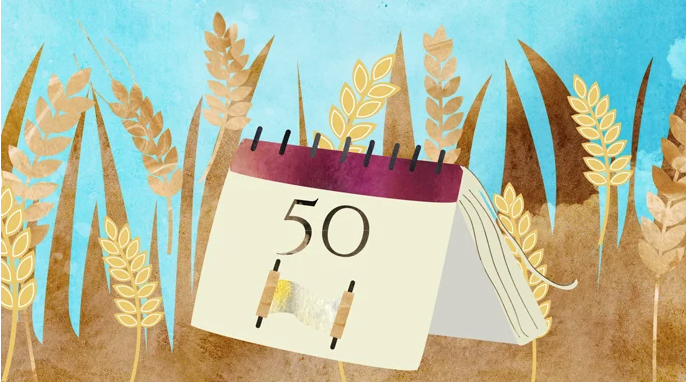
1. The Omer Count Is 49 Days Long
The Omer Count is an annual mitzvah. Every day, for seven weeks (49 days), we count how much time has elapsed since the second day of Passover (16 Nissan).
Read: What Is the Omer Count?
2. We Count Days and Weeks
On the first day, we say, “Today is one day to the Omer.” Once we reach the seventh day, we count weeks as well, saying, “Today is seven days, which is one week to the Omer.” On the following day, we say, “Today is eight days, which is one week and one day to the Omer.”
3. It Ends the Night Before Shavuot
After 49 days have passed (on 5 Sivan), we say, “Today is 49 days, which is seven weeks to the Omer.” On the following day, number 50, we celebrate the holiday of Shavuot, which literally means “weeks.” Indeed, counting the 49 days actually brings about Shavuot. This means that one who crosses the International Date Line during the Omer may very well end up celebrating Shavuot on a different day from everyone else.
4. Omer Is a Measure of Grain
“Omer” is an ancient grain measurement (equivalent to approximately 43 oz.). On the first day of the Omer count (the second day of Passover), an omer of the barley from the fresh crop was offered in the Holy Temple, and after that day, grain from the new crop was allowed to be consumed.
5. Count Standing Up
The verse (Deuteronomy 16:9) tells us to begin counting the Omer when the scythe first meets the kamah, “standing [stalks].” Noting that the word “standing” is said in connection with this mitzvah, the sages tell us that it is ideal to stand when counting the Omer.
6. We Say a Special Blessing
Like we would do before just about any mitzvah, when counting the Omer each night we say a blessing: “Blessed are you, L?rd our G?d, King of the Universe, Who sanctified us and commanded us regarding counting the Omer.”
7. We Count at Night
The best time to count the Omer is after evening services, right after the new Jewish day (which starts at nightfall) has begun, so that you have a full day ahead of you. In the event that you forgot to count at night, you can count the following day as well, but you do not say the customary blessing.
8. Every Day Counts
Omer is a unique mitzvah in that it spans 49 days. In the event that you missed a day entirely, you should continue to count each night just as before, but you do not say the customary blessing, since it is possible that the missed day invalidated the completion of your mitzvah.
9. The Sadducees Counted Differently
Scripture tells us to begin counting the Omer “on the day after the rest day.” Tradition understands this to mean the day after the (first day of) Passover. However, there were once Jewish splinter groups that interpreted it to mean that the count must always begin on a Sunday, which follows Shabbat, the day of rest. This approach was thoroughly negated by the sages.
10. Each Day Corresponds to Another Spiritual Facet
According to the Kabbalah, we each have seven middot (emotional elements): chessed (“kindness”), gevurah (“strength”), tiferet (“harmony”), netzach (“perseverance”), hod (“humility”), yesod (“foundation”), malchut (“royalty”). Each of these elements further comprises all seven attributes. Thus, we have “chessed of chessed” followed by “gevurah of chessed” etc. all the way to “yesod of malchut” and finally “malchut of malchut.” This makes for a total of 49 micro attributes, since 7×7=49.
On every day of the Omer count, we work on ourselves, attempting to refine the parts of our own personalities that correspond to that day’s attributes.
11. It Recalls the Anticipation for Sinai
The Exodus from Egypt happened on the first day of Passover, and the Revelation at Sinai happened on the day that would become Shavuot. It follows that from the day of the Exodus, the Israelites eagerly looked forward to the events that would happen at Sinai, counting the weeks and days until the time would arrive, each day refining themselves a bit more and raising their spiritual sensitivity. When we count the Omer, we relive their excitement and anticipation.
12. It’s the Only Mitzvah that Spans 3 Months
The holiday of Chanukah, when we light the menorah each night, starts during the month of Kislev and ends in the following month, Tevet. Counting the Omer takes the cake, however, spanning three months, starting in Nissan, continuing through Iyar, and concluding in Sivan.
Read: 12 Facts About the Month of Nissan Every Jew Should Know
13. Yep, There’s An App for That!
Remembering to count each night and making sure to count properly can be a challenge. To help you with your Omer count (besides for Shabbat and Jewish holidays, when technology is forbidden), Chabad.org’s team has created the super-popular Omer App. Download it and start using it—you’ll be glad you did!
Download: The Omer App

Source: Chabad.org